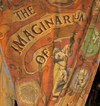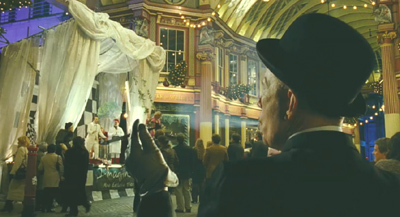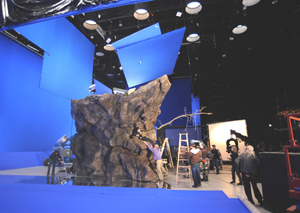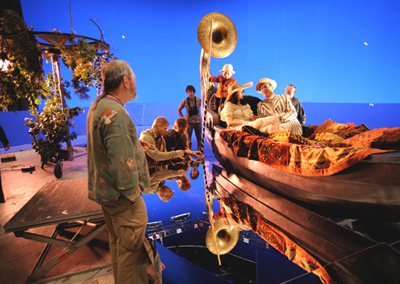|
THE TERRY GILLIAM FILES // "IMAGINARIUM" (2009) |
Production Designer Anastasia MasaroOn Creating Sets for
|
 |
|
The Canadian designer's credits included Vincenzo Natali's CUBE (1997) , the Stephen King mini-series STORM OF THE CENTURY and the films THE PERFECT MAN and HONEY before being hired as art director for Terry Gilliam's TIDELAND. She re-upped for THE IMAGINARIUM OF DOCTOR PARNASSUS.
Out there the difficulty was we were shooting in Regina, our home base was in Regina, but our sets were out in the Qu'Appelle Valley, a lot of them. And we were building things in the middle of nowhere essentially. There a was a house in the middle of the field and I remember in order to even get out to main house in TIDELAND they had to actually lop off the top of a hill so that cars could actually even get up over the hill. And it was so dry, it was really, really beautiful, big skies. And I remember people smoking, and I would have nightmares that somebody who flick a cigarette and the whole field would be set on fire because it was so dry: Could we put up signs that say 'No smoking'? It was definitely more relaxed than PARNASSUS. PARNASSUS was madness, it was complete madness. It's just the most mad project I ever worked on because of the circumstances, and that was before Heath's passing. We were in London, we were set at a river, we were in a storage facility as our offices — very glamorous! And even the circumstances of how I got the project were a little strange. I'd had dinner with Terry because I was working on something else in London I think maybe a couple of months before. And I was about to leave London. Three days before I leave Terry calls and says 'I have an interesting proposition for you. How about we meet? I'm going to send you something.' OK.
And then all of a sudden I get this script where I get to make this giant toy theater. And I was like, This was very weird. And then we were going to shoot Bond Street, and Bond Street became really difficult Because of security reasons, just getting the wagon onto that street, and we ended up at Leadenhall Market. That's the scene where Heath is drawing in all the well-to-do lady customers? Masaro: Yes, and the wagon in transformed into the black and white stage. And then later after Heath's passing there was the ladder world. Terry had done this image with Jude Law on some ladders that he had had for preliminary artwork when he was trying to get budgeting for the film. He was on our wall for the longest time even before he was ever going to be involved in movie. There was a lot of juggling between who was going to play what world, between Jude, Johnny and Colin. We didn't know until maybe a week or two before who was doing what. I think the first AD had made I don't know how many schedules and we just kept trying to building everything as much as we could because we didn't know what would be the first setup. And then all of a sudden Jude Law is doing the ladder world. So many strange things were happening! In London it was that was a really short preproduction. I'm sure you heard about the difficulties of the wagon. The wagon could really have used some more prep time. For set dressing? Masaro: No. I was there dressing until midnight the night before we went to camera. I think Caroline was there until three in the morning. It wasn't the dressing so much as the preparation. It would have been nice to have tested the wagon more and just make sure all of its mechanisms were working properly. It was a monster racing down the streets of London, and it has horses attached to it! I remember at one point I was in there about a week before we were to go before cameras, and the front tires were sagging, like the wagon's too heavy, the tires were just squishing down. How was the wagon engineered — was a ready-made wagon taken and built onto? Masaro: No, absolutely not. The chassis was built specifically for our wagon so there was a metal frame and it had wooden pieces attached to it that came off so that we could then shoot through it and be inside. Because initially I wanted to build an interior and exterior, and I was told we didn't have the money for that. So you had removable walls? Masaro: We had fly walls that attached to a metal frame, which was then covered up with wood and dressing on the inside. It was the same wagon on the inside as it was on the outside. We then shipped the wagon except the chassis to Vancouver because it was not going to be seen on Vancouver streets. At first there was a moment where it was going to be seen but that location got cut. So we were not going to see it on the streets of Vancouver. So just the frame and wood pieces got sent over. Just for the interiors. And we had the wagon open on a couple of scenes on stage. Vancouver posed a different problem. We had three different stages that we shot on, and we also had about six locations. We did two flashback sequences in the 1930s, and we had the end sequences [where Doctor Parnassus demonstrates the toy theatre]. We shot at the Orpheum [and] at the Vancouver Public Library. The challenge in Vancouver was first of all getting all of that scenery built. People think you just put actors in front of blue screen and you call it a day. It was a lot of construction; we actually spent more money in Vancouver than we did in London in construction. The hard part there was we had three studios. One of them was small, so we pretty much only shot the wagon in pieces of it, like Parnassus' den. But the other thing was our construction shop was not on-site. It was ten minutes' drive up the street but it was still off-site and the construction site was small. For the larger sets, like the monastery where we built all the stone floor and the tree and the minbar, we never saw everything put together until we moved it into the studio. So nothing was seen in its entirety. How much time did you have between getting all the set pieces onto the stage and having to go before the camera?
It wasn't originally designed for floating monks? Masaro: No, Terry decided it! Terry does these great things where he — it's great, he just keeps going. And he decided Wouldn't it be nice if the monks were floating? And then it got worse. It became Wouldn't it be nice if when Mr. Nick opens the door that the winds blows them? I love that moment. Masaro: Oh my God, on the day making sure that they all coordinate moves, in harmony, and we have fire in the minbar and, yeah, that took up the largest space and that was the most amount of time. Poor Shane Vieau was certainly tried on that movie. Shane Vieau was the decorator in Vancouver. I pretty much touch everything until the unit moves in. I'm pretty much not happy with anything! I hold myself to my own standards, not so much to anybody's else, but I keep touching everything, which was a pain for Shane. Because on top of it, Terry's not ever happy with anything. With the scenes inside the Imaginarium, there was obviously some CGI involved in painting in the backgrounds. But while most CGI nowadays is intended to look realistic, here it was mimicking the look of painters like Grant Woods and Maxfield Parrish, and you couldn't tell where the sets ended and the CGI began. So your set pieces and props could not look "realistic," either, if they were to blend in with the backgrounds.
This is the thing on this movie: every set that I had pretty much had to be transformed into another set. We had a large hill that was used for the Jude Law sequence with the tarred trees, and that got changed over into a big hill with the Astroturf on it, and we also had another giant slope that we used with Astroturf on that, and the flowers were real, we planted that in. Each set posed a new problem. Like with Astroturf you think, what could go wrong with Astroturf? Well, we somehow lost it on its way to Vancouver. So on the first day of shooting Construction didn't tell me and thank God that they didn't because it wound up changing over and we wound up not shooting that first set. But nobody knew where the Astroturf was. It was all problems, all problems. Yeah, that was actually the one thing that I think we're all pretty proud of on that movie in the art department, was how we changed sets over, and how we maximized every dollar that we had.
It was also used for the sequence where you see the horseman arriving at the interior of the monastery. It came apart in half so that it was easier to shoot. Most of the sets were like that. Time, space and money: Those were the problems on this one. Is that all? Masaro: It was madness, it was absolute madness. I think Paint did not have a day off in two months. One of them wound up with pneumonia at the end. Did you do any work on the jellyfish sequence? Masaro: That concept art [by Imery Watson] was done in development when Terry had done the book to try to get the money. We didn't do anything for the jellyfish. There was talk [at the beginning], but in the end it was really all stunts and the FX, that sequence. You did build part of Mr. Nick's Bowler Hatbar. Masaro: Mr. Nick's Bowler Hat Bar was two things — it was one of our miniatures that was built in London, and the entire front (where you see him enter the bar), that was built on stage. We had considered in London this beautiful . . . I want to call it a pub but it was probably a nightclub somewhere . . . and it was beautiful on the outside. And so I had taken my photos of that back to Vancouver and I [used pieces] of it for Mr. Nick's bar. Same for the tarred trees: At first Terry had suggested a stone landscape for those trees and then he said what about red coral. I was taking the bus to work in London, and I remember passing these strange steps, I don't know what it was, but people had tarred their stairs — I just assumed that hadn't finished whatever project they were working on — and it was drippy tar, and I said, 'How about we do tarred trees?' And Terry went with it. With that one I thought It would be really nice to have all the tar dripping down on the ground. Then how do you make the drippings? So on the day the foam was sprayed, I ran into the shop saying 'Don't waste the foam!' We had all the floor covered in plastic to catch all the drippings. What was the location of the award ceremony? Masaro: That's the Orpheum in Vancouver. What I did to try to make it at least look like what we did at the studio [when Tony's world "falls apart" around him] was that large carpet — that was the piece that was going to tie everything together. Because you need a rug to tie the room together. Masaro: Yes! You always need a rug to tie the room together! Shane had managed to find original carpeting that matched the Orpheum's and we brought that into the studio. We built stairs and a bit of floor and the carpet, so that was done — of course, with some sand at the end.
Masaro: The boat was the same, we decided to keep the boat the same throughout. [On the boat] it was the same sunburst as you see the woman bursting out of in the black and white sequence in Leadenhall market. Not a lot of people catch that. The set for Johnny Depp and Collin Farrell were different. For that sequence with Johnny the bridge was real, the walkway that he walks on is real. And then Collin's sequence was built as well. There were a lot of exterior grounds that were actually built in the studio. Such as when Parnassus wanders off to the end of the world? Masaro: Yeah, that was all sand in the studio, so that wasn't that difficult. One of the ones that we did on the fly was Collin's which we called the Puddle of Tears set, because the little girl is standing in a puddle of her own tears. Terry and Nicola decided that they needed a connecting shot between where Jude/Tony and Andrew Garfield's character are talking and Jude wants to know how does this all work, and they're supposed to be in Battersea. And then we pan out and you see there's the wagon set up in Battersea power station. That ground was turned into Battersea. And it was turned into Battersea pretty much in an afternoon with a crew who had never seen it. So it was basically me and some pictures and it looks fantastic. I remember Terry saying 'Oh My God this looks exactly like it!' It's little things like that you know make you know that you have a good crew with you. Can you describe your work with the conceptual artist and designer Dave Warren? Masaro: I worked with Dave in London and he would provide the sets in London when I was shooting in Vancouver or when I had gone to Vancouver — I was not there for the entire shoot in London because somebody had to go prep the Vancouver crew. A lot of Dave's sketches were done in pre-production. My sketches — they don't look anything like his! — I sketch what I want construction to actually build, Basically what I want the set to look like. He was drawing a lot of feel, and he was taking a lot of things that we's all discussed and putting those and conceptualizing those. And he's super fast, super fast, But I do my own images for my crew.
Masaro: All of us have so many books, I arrived in London with a bunch of my own books, and Terry had his own library. We were looking at alchemy, mysticism. I had a book on Mexican home altars that I wanted to put in as well — Where can I put this? — because I just had a feeling it would work with the show. We used that later with the boats, the little commemorative boats [which carry portraits of Rudolph Valentino, James Dean and Princess Di, all icons who had died young]. With the dressing of the wagon I went out with Caroline Smith because I had never worked with Caroline before, she was the decorator in London. And we did a big day of looking around, shopping, taking photographs at rental house, prop houses and just stores, so that we could get the feel for each other and also that we could show Terry things that we wanted. I also shopped on my own on the weekends. We kind of just went by feel. You know when something is right. We knew the vibe that Terry wanted. We knew that Parnassus had been around for thousands of years, and we wanted to layer different moments in history into the wagon.
Using bits from each? Masaro: Yeah. We made that large mirror from three different mirrors. It was an actual mirror but It was Mylar when you walk through it. The good thing about the wagon, it's got so many periods, it's got so many styles, it's got some many types of architecture, that it's easy to introduce new pieces to it. Accruing different influences over time. Masaro: And then places that he had traveled to as well. So I used books on Indian interiors, I used books on Alpine interiors. The good part about those sets is we could also keep going. If those sets were still standing, I could still be improving them. I still want to touch them. I still want to dress them! I would make a horrible painter, wouldn't I? I cannot stop touching. But the camera has to roll. Masaro: The camera has to roll. Thank God, or Terry could be touching, too! As he told me on the first movie I worked with him on, 'I vacillate.' I want to make a T-shirt with "Vacillate" with a big X through it. We don't have time or money for vacillating! What about the set with the painted flats of trees?
'This is the thinnest.' So, we tapered the sides, we beveled the sides so it would look thinner. They look really thin when you see them on camera! 'But I wanted them thin!' And I'm like, 'You gotta be kidding me! It's magic! I can't perform magic. We have enough magic on this movie. I can't do this one. ' He certainly pushes! He definitely pushes. What from IMAGINARIUM are you most proud? Masaro: For sure that the crew held together the way it did, 'cause that was a pretty awful day for so many people on so many different levels. I will never forget that day. We held together and we kept pushing. In terms of the sets, I think I am most proud of how the monastery turned out, and Parnassus' den. Those two were an absolute joy. Those were the closest to perfection, for me anyway. UPDATE: Masaro, along with Dave Warren and Caroline Smith, received Academy Award and BAFTA nominations for the design for PARNASSUS.
|
|||||||||||||||
copyright 2009, 2010 by David Morgan
All rights reserved.








 A couple of days before I had discovered Leadenhall Market. I was walking the city at night and came upon Leadenhall Market. It was completely closed and I went Wow! What is this beautiful place? I'd had also gone to Pollock's [Toy Museum] and basically got all these things to make a toy theatre — I'd become obsessed by toy theaters.
A couple of days before I had discovered Leadenhall Market. I was walking the city at night and came upon Leadenhall Market. It was completely closed and I went Wow! What is this beautiful place? I'd had also gone to Pollock's [Toy Museum] and basically got all these things to make a toy theatre — I'd become obsessed by toy theaters. Masaro: That was the one where we had the most time, and that was four days. It was going to be impossible. It wasn't just about our construction, it was grips and electric and the effects. Terry had decided he wanted the monks to float. All of a sudden there's 30 pick points that need to be dealt with.
Masaro: That was the one where we had the most time, and that was four days. It was going to be impossible. It wasn't just about our construction, it was grips and electric and the effects. Terry had decided he wanted the monks to float. All of a sudden there's 30 pick points that need to be dealt with. Masaro: Which was very helpful on this movie actually, that it didn't have to look real. We had Grant Woods' illustration as an inspiration. For that one we built three different ladders to do three different things. Those were in one separate stage with no grass to be seen. The rest of that sequence we had ordered Astrotuf from Georgia Ð the most beautiful Astroturf you've ever seen, it really was. That was the most requested item on that show at the end by the crew: Can we have the Astroturf? It looked gorgeous!
Masaro: Which was very helpful on this movie actually, that it didn't have to look real. We had Grant Woods' illustration as an inspiration. For that one we built three different ladders to do three different things. Those were in one separate stage with no grass to be seen. The rest of that sequence we had ordered Astrotuf from Georgia Ð the most beautiful Astroturf you've ever seen, it really was. That was the most requested item on that show at the end by the crew: Can we have the Astroturf? It looked gorgeous! In the clips you see the cliff set with the gibbet, the hangman sequence, that was actually three different sets we produced for. It was 14 feet high with a steel structure, and on one side it was the gibbet with the stairs going up, and on the other side it was the sequence where Mr. Nick fishes Parnassus when he throws himself off the cliff. The front nose comes off of the cliff, and so it looked like a rocky crag when Parnassus throws himself off, Then that piece got removed so when we used it as the gibbet, it looked like a different set.
In the clips you see the cliff set with the gibbet, the hangman sequence, that was actually three different sets we produced for. It was 14 feet high with a steel structure, and on one side it was the gibbet with the stairs going up, and on the other side it was the sequence where Mr. Nick fishes Parnassus when he throws himself off the cliff. The front nose comes off of the cliff, and so it looked like a rocky crag when Parnassus throws himself off, Then that piece got removed so when we used it as the gibbet, it looked like a different set. Was the same Venetian-style gondola the same in the Imaginarium scenes and in the flashbacks with Parnassus and his wife?
Was the same Venetian-style gondola the same in the Imaginarium scenes and in the flashbacks with Parnassus and his wife? 
 Even the way we found the mirror — Caroline and I went out and we found three Venetian mirrors and bought all three and came back and put them all together.
Even the way we found the mirror — Caroline and I went out and we found three Venetian mirrors and bought all three and came back and put them all together. Masaro: That was in Canada. All the interiors, the stage were all in Canada. That was a built floor, and then we had large cutout trees made out of gatorboard and plywood. I remember Terry wanted them thin! thin! thin! but he wanted to magically have them stand up. We can't just have thin canvas that we can't hang then from the ceiling. 'But they have to be standing!'
Masaro: That was in Canada. All the interiors, the stage were all in Canada. That was a built floor, and then we had large cutout trees made out of gatorboard and plywood. I remember Terry wanted them thin! thin! thin! but he wanted to magically have them stand up. We can't just have thin canvas that we can't hang then from the ceiling. 'But they have to be standing!'